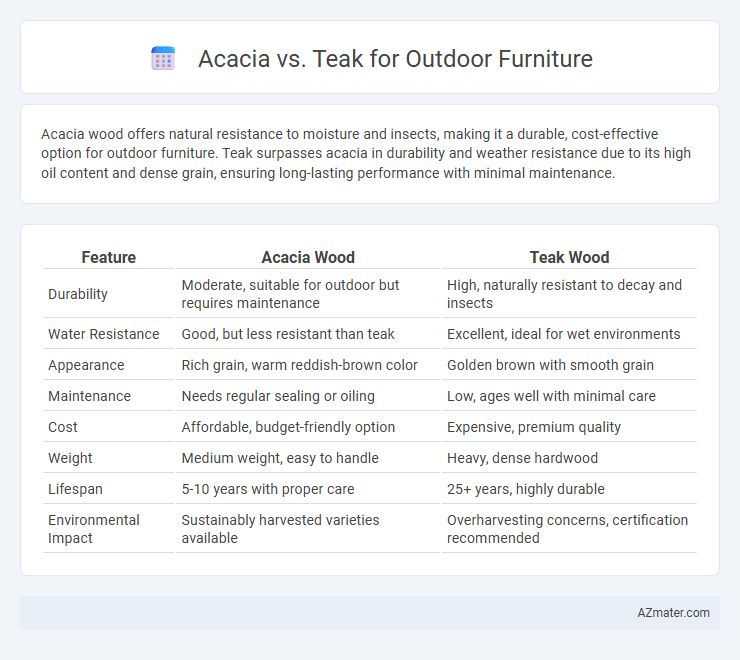Acacia wood offers natural resistance to moisture and insects, making it a durable, cost-effective option for outdoor furniture. Teak surpasses acacia in durability and weather resistance due to its high oil content and dense grain, ensuring long-lasting performance with minimal maintenance.
Table of Comparison
| Feature | Acacia Wood | Teak Wood |
|---|---|---|
| Durability | Moderate, suitable for outdoor but requires maintenance | High, naturally resistant to decay and insects |
| Water Resistance | Good, but less resistant than teak | Excellent, ideal for wet environments |
| Appearance | Rich grain, warm reddish-brown color | Golden brown with smooth grain |
| Maintenance | Needs regular sealing or oiling | Low, ages well with minimal care |
| Cost | Affordable, budget-friendly option | Expensive, premium quality |
| Weight | Medium weight, easy to handle | Heavy, dense hardwood |
| Lifespan | 5-10 years with proper care | 25+ years, highly durable |
| Environmental Impact | Sustainably harvested varieties available | Overharvesting concerns, certification recommended |
Overview: Acacia vs Teak Outdoor Furniture
Acacia and teak are two popular hardwoods used in outdoor furniture, each offering unique benefits and characteristics. Acacia wood is known for its rich, warm tones, high durability, and resistance to weather and insects, making it a budget-friendly option for outdoor use. Teak, prized for its superior natural oils, exceptional strength, and long-lasting resistance to moisture and decay, is often considered the premium choice for outdoor furniture with a classic, elegant appearance.
Durability and Weather Resistance
Acacia wood offers remarkable durability and natural resistance to weather elements, making it a popular choice for outdoor furniture in humid and rainy climates. Teak wood exhibits exceptional weather resistance due to its high oil content, providing superior protection against moisture, insects, and UV rays, which helps it age gracefully with minimal maintenance. While teak furniture generally commands a higher price, its long-lasting durability combined with low upkeep makes it an excellent investment for outdoor settings exposed to harsh environmental conditions.
Appearance and Aesthetic Appeal
Acacia wood features a rich, warm hue with intricate grain patterns that enhance outdoor furniture's natural beauty, offering a rustic yet refined aesthetic. Teak showcases a golden-brown color that ages to an elegant silver-gray patina over time, providing a timeless and sophisticated look. Both woods bring unique visual appeal, with Acacia emphasizing vibrant warmth and Teak delivering classic elegance for outdoor settings.
Maintenance and Care Requirements
Acacia wood requires regular oiling and sealing to maintain its durability and resistant properties against moisture and UV damage, whereas teak wood naturally contains oils that reduce the need for frequent maintenance while offering superior resistance to pests and rot. Acacia may develop cracks or fade if neglected, demanding more attentive care to retain its aesthetic appeal, while teak's dense grain allows it to weather gracefully with minimal upkeep, often only needing occasional cleaning and sanding. Both woods benefit from protective coverings during harsh weather, but teak's low-maintenance profile makes it ideal for long-lasting outdoor furniture in diverse climates.
Cost Comparison: Acacia vs Teak
Acacia outdoor furniture is significantly more affordable than teak, with prices typically ranging from 30% to 50% lower. Teak commands a premium cost due to its exceptional durability and natural oils that resist weathering and pests, making it a long-term investment. Budget-conscious buyers often prefer acacia for its cost-effectiveness while still offering good weather resistance and aesthetic appeal.
Sustainability and Environmental Impact
Acacia wood offers greater sustainability due to its rapid growth cycle and widespread availability, making it a more eco-friendly choice for outdoor furniture compared to teak. Teak's slow growth and high demand contribute to deforestation and habitat loss, raising significant environmental concerns. Choosing acacia helps reduce carbon footprint and promotes responsible forestry practices while still providing durable, weather-resistant outdoor furniture.
Weight and Practicality
Acacia wood, known for its moderately heavy weight, offers excellent durability and resistance to weather, making it practical for outdoor furniture that requires both sturdiness and ease of mobility. Teak is heavier and denser, providing superior strength and natural oils that repel water and pests, ideal for long-lasting outdoor pieces but less convenient to move frequently. Both woods deliver high durability, though acacia balances weight and practicality better for users needing manageable furniture.
Lifespan in Outdoor Settings
Acacia wood offers a lifespan of around 10 to 15 years in outdoor settings due to its natural oils and dense grain that resist moisture and decay. Teak wood outperforms acacia with a lifespan exceeding 20 years, attributed to its high silica content and natural oils that provide exceptional resistance to rot, pests, and weathering. Both woods require regular maintenance, but teak's superior durability makes it the preferred choice for long-lasting outdoor furniture.
Suitability for Different Climates
Acacia wood offers excellent durability and natural resistance to moisture, making it highly suitable for humid and tropical climates where outdoor furniture is exposed to frequent rainfall. Teak wood contains natural oils and silica that provide superior weather resistance, ideal for hot, sunny, and salty coastal environments, preventing warping and decay. Both woods perform well outdoors, but Acacia is better for wet climates due to faster drying properties, while Teak excels in harsher, sun-drenched settings with its long-lasting strength.
Pros and Cons Summary
Acacia wood offers excellent durability, natural resistance to water and insects, and a rich, warm color that enhances outdoor furniture aesthetics, but it requires regular maintenance to prevent cracking and fading. Teak wood is highly prized for its exceptional strength, natural oils that provide superior weather resistance, and minimal maintenance needs, although it tends to be more expensive and heavier than Acacia. Choosing between Acacia and Teak depends on budget, desired longevity, and willingness to perform upkeep for outdoor furniture.

Infographic: Acacia vs Teak for Outdoor Furniture
 azmater.com
azmater.com